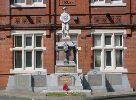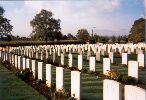
Newton-le-Willows and
Earlestown War Memorial

| OTHER WARS |
 |
Newton-le-Willows andEarlestown War Memorial |
 |
| The
Great War Roll of Honour |
|||||||||||||||||||||||||
Captain H. Whalley-Kelly, in his book “Ich Dien –
The Prince of Wales’s Volunteers”, gives the following account:
“ The scene now changes from the rugged hills and steep ravines of Gallipoli,
and the yellow sands of Egypt, to the flat, featureless deserts of Mesopotamia,
the land of the two rivers, where the Battalion was destined to spend the rest
of the war.
On 25th February, after an uneventful voyage through the Red Sea and Persian
Gulf, the Arab town of Koweit at the mouth of the Shatt-el-Arab was reached.
Here the Battalion transhipped to a steamer with shallower draught, and soon
arrived at Basra, the base port - a city associated by tradition with the adventures
of Sinbad the Sailor, but nevertheless, with its squalid streets and evil-smelling
canals, of unromantic aspect. After a short sojourn in Magil Camp the Battalion
embarked in river steamers and continued its long journey to the battle-front
up the winding River Tigris; past Qurna, where the waters of the Euphrates join
with those of the Tigris to form the Shatt-el-Arab, and the reputed site of
the Garden of Eden; past the blue-tiled dome of Ezra's tomb; past the dishevelled
mud villages and scanty palm groves of this barren land to a desolate camp at
Sheikh Saad, then flooded with the winter rains.
The 13th Division arrived in the theatre of operations at a critical moment.
In 1914 a force, composed mainly of Indian troops,had been dispatched to the
Persian Gulf with the primary object of protecting the Anglo-Persian oilfields
which formed one of the chief sources of supply of this essential commodity.
On first landing only weak Turkish forces of irregular Arab levies, stiffened
by some regular units and artillery, had been encountered. These had been easily
defeated and had retired up-river. The ease with which the initial success had
been gained, however, combined with the presence of Turkish forces on the Euphrates,
and south of Baghdad, still in a position to threaten the pipe-line from the
Persian hills,persuaded the British commander to extend the area of operations.
The hostile detachment on the Euphrates was defeated at the Battle of Shaiba
in 1915, and the advance was continued up the Tigris to Amara with the object
of establishing a defensive zone to control the approaches by either river,
these waterways providing the only routes in this undeveloped country by which
large forces could move. All through that summer the position was consolidated.
More troops were sent from India, and by the time the cold weather had set in
a force of approximately one division under Major-General Sir Charles Townshend
was available, and within striking distance of Baghdad. Things were not going
too well on the Western Front; the capture of Baghdad would enhance our prestige
in the East as well as providing a spectacular military achievement: so argued
the politicians at home, and consequently the Commander-in-Chief in Mesopotamia,
Sir John Nixon, was ordered to make the attempt.
Townshend's force was accordingly set in motion, and on 22nd November fought
the Battle of Ctesiphon almost within sight of the domes and minarets of the
coveted city, only to have victory snatched from its grasp by the unexpected
arrival of Turkish reinforcements. Townshend, with a precarious line of communications
behind him, uncertain of his supplies and confronted by a now superior enemy,
had no alternative but to retreat. The hasty attempt to capture Baghdad had
failed, and the Turks under an energetic Commander, Khalil Pasha, pursued vigorously.
Hard-pressed and encumbered by a large convoy of sick and wounded, the British
force eventually made a stand in Kut-el-Amara, where it was quickly surrounded
and besieged.
The story of the siege and the desperate attempts to raise it in the early months
of 1916 can find no place in this story; suffice it to say that more and more
troops were drafted to Mesopotamia and thrown piecemeal into attacks which broke
down owing to the difficulty of advancing over flat, open, water-logged ground
in the face of modern fire-power. The 13th Division was the last of the reinforcements
to arrive, and Kut was still holding out, although the garrison were now getting
short of food and ammunition. A new attempt to relieve it had to be made without
delay.
This, then, was the general situation, and an expedition which had started with
a strictly limited object had grown into a first-class campaign which absorbed
men and material in ever-increasing quantities.
It is hoped that the foregoing brief review of the preceding events will enable
the reader to follow the operations now about to be described in which the Battalion
played its customary gallant part, and we can now return to the story of its
doings. On 21st March the Battalion was moved to Wadi Camp, together with the
rest of the 38th Infantry Brigade, and on the 26th the Commanding Officer, Adjutant,
and Company Commanders from our trenches on the left bank of the Tigris reconnoitred
the enemy position facing Hanna in readiness to attack it.
At 4.45 a.m. on 5th April the assault commenced. The first line of Turkish trenches
was taken by the 6th King's Own Royal Lancaster Regiment, and the second by
the 6th East Lancashire Regiment, covered by a barrage put down on the third
line. After the capture of the first and second lines, our artillery fire lifted
and the Battalion, under Lieutenant-Colonel Charlton, rapidly advanced and occupied
the third series of enemy trenches with few casualties. By 7 a.m. the whole
of the Hanna position was in British hands, a few prisoners had been collected,
and the Turks had withdrawn to their defences up-stream at Falahiya, leaving
a large number of dead on the ground. The Battalion then took part in consolidation
of the gains, preparatory to attacking the Falahiya position at 7.35 p.m. the
same evening.
The bombardment for this fresh attack commenced at 7 p.m. and at zero the Battalion
moved forward with perfect steadiness under heavy rifle fire. By 9 p.m. the
Falahiya position had been captured, but the fact that 3 officers and 23 men
of " A " Company alone were found dead in front of the Turkish wire
is sufficient testimony to the severity of the fighting, and the accuracy of
the enemy's fire.
The same night the Battalion was relieved by a unit from the 7th (Indian) Division
and went into bivouac. After a rest of twenty-four hours it was moved forward
again to take part in an attack on the strong Turkish position at Sannaiyat,
timed for the early morning of 9th April - an attack, unfortunately for the
defenders of Kut, which it was found impossible to push home.
In the light of our present knowledge it seems clear that the Turks were forced
by the encroachment of water from the flooded Tigris to abandon prematurely
their position at Umm al Hanna, and that the Falahiya trenches were only held
to gain time for them to put their house in order at Sannaiyat, about three
miles farther up the river. Here, with his right flank resting securely on the
Tigris and his left guarded by the Suwaikiya Marsh, the enemy awaited our next
move. On 6th and 7th April troops of the 7th Division made determined efforts
to capture the Sannaiyat position, but the assaults failed with heavy loss,
and a new line of shallow trenches some four hundred yards from the Turkish
wire was the full measure of achievement on these two days.
The operation orders for 9th April legislated for the 13th Division advancing
on a front of two brigades, the 38th on the right and the 40th on the left,
while the decimated 7th Division was echeloned to the right rear in readiness
to exploit success. The flooded state of the Suwaikiya Marsh made a turning
movement impracticable, and the frontage on which attack was possible was thus
reduced to about twelve hundred yards - in other words, manoeuvre was impossible,
and the attackers were confined to the bottle-neck of comparatively dry ground
between the Tigris and the marsh.
By 2 a.m. on the 9th the Battalion was formed up on its starting-line in four
lines of platoons in column at fifty yards distance, with the 6th King's Own
on the right and the 6th East Lancashires on the left in the same formation.
The objectives were only 650 yards away across the plain, and consequently the
men had to lie down while waiting for zero. It was a bitter night, and during
the long wait everyone became numb with cold.
At 4.20 a.m. the long lines of infantry moved off silently and punctually, covering
the first few hundred yards quickly and easily. When the leading platoons came
within a hundred yards of their wire, however, the Turks fired a number of flares
obliquely from their front, causing some confusion in the direction of march.
At the same time they opened a heavy fire with machine guns and rifles, followed
almost immediately by a storm of well-directed shells. The rapidity with which
this defensive fire was put down seems to indicate that the enemy was well aware
of the impending attack, and as our own artillery bombardment was ten minutes
late in commencing it failed to synchronize with the assault-a disastrous error
which, combined with the confusion caused by the Turkish flares, prevented all
but the leading platoons closing with their opponents. These small parties entered
the trenches and drove the enemy back to his second line, but they were unsupported
and unable to get farther forward. The Turks rallied and counter-attacked, regaining
their front 1ine, although the gallant survivors of the invading platoons held
their own until their bombs gave out.
Dawn was now breaking and it proved impossible to rally and reorganize units
in daylight under heavy fire, and on ground devoid of any cover. Some companies
of the Brigade managed to dig in where they stood, but the remainder fell back
to the starting-line. By dusk, however, it was clear that there was nothing
to be gained by staying out in shallow trenches in exposed localities, and the
forward companies were withdrawn also. Later a new line was consolidated about
400 yards from the Turkish position.
The non-success of the attack on the Sannaiyat position was not due to lack
of courage on the part of the troops engaged, but their ranks now contained
a large percentage of inexperienced soldiers, and owing to the casualties in
the previous assaults all units were lacking in trained officers and junior
leaders. Further, the difficulties and hazards of a night attack must never
be forgotten, even with the most highly trained and seasoned troops."